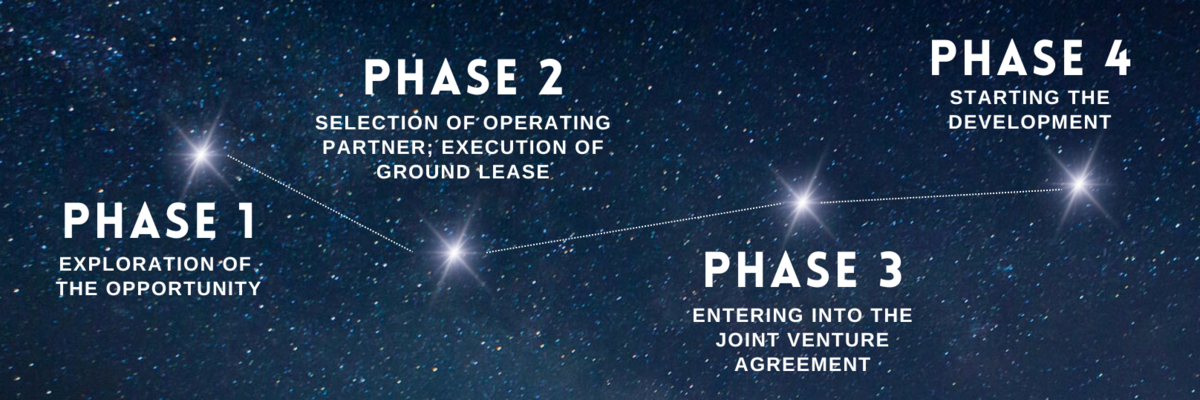The University of California, Office of the President's (UCOP) official involvement began in 2008 in response to NASA's 2002 Long Range Development Plan, which designated the Moffet Site for educational use. The current Berkeley-led effort began in December 2018. Since then, the campus has worked quickly and earnestly to assess the project and lay the foundation for its realization and success.

Phase One - Exploration of the Opportunity
-
NASA completed an Environmental Impact Study (EIS) in 2002 which reserved approximately 77 acres of the NASA Ames Research Center for academic use. At the invitation of NASA Ames, the University of California explored multiple opportunities for the site, with UC Santa Cruz making a meaningful attempt to build out the site for its use along with three other higher education institutions (University Associates). That effort ended in 2008.
-
In 2018, UC Executive Vice President Brostrom contacted Regent Emeritus DeFreece to explore whether UC Berkeley (Berkeley) would be interested in taking on the opportunity of leasing the site from NASA Ames. Working with Executive Vice Chancellor and Provost Alivisatos, who acted as an executive sponsor, DeFreece started exploratory conversations with NASA Ames.
-
The same year, a steering committee led by Dean Emeritus Rausser, and composed of key Berkeley faculty within relevant academic disciplines evaluated the viability of the project given the constraints (no use of Berkeley balance sheet or funding available for the project) and the issues that kept the previous attempt at development from being able to move to the CEQA phase. The faculty steering committee finalized The Rausser Report which outlined opportunities and risks of the development and potential joint initiatives to be pursued with Berkeley, NASA and industry partners.
-
After developing an internal model and reviewing the forensic report on the previous attempt, a path forward was developed. That approach relied on finding a private development partner who was willing to enter into a joint venture with Berkeley and share profits from a successful development, while absorbing the financial risk of an unsuccessful development.
Phase Two - Selection of Operating Partner; Execution of Ground Lease
-
In the summer of 2019, Berkeley issued a request for quote (RFQ) for an operating partner that would bear the responsibility of developing the site and finding third party capital. Eight companies bid on the opportunity, and a campus committee recommended to the Chancellor two potential strong partners. Chancellor Christ chose the team from SKS Partners and the Prado Group (SKS/Prado), due in particular to their successful execution of projects at UC San Francisco.
-
With the expertise and aid of SKS/Prado, Berkeley successfully negotiated a ground lease with NASA in the winter of 2020, for up to 99 years at NASA Ames for 36 acres and 1.4 million square feet of federally entitled space, under the National Environmental Policy Act (NEPA).
Phase Three - Entering into the Joint Venture Agreement
-
During Covid, Berkeley embarked on an effort to define and enter into a joint venture with SKS Partners (Prado Group later left the opportunity), and in 2022 the joint venture agreement was signed.
-
The Joint Venture (JV) is unique to the UC system for at least three respects:
-
It is not a public-private partnership, although it must advance the public mission of the University,
-
It is a private development, where Berkeley is contributing the ground lease and its reputation and brand in exchange for an even share in the profits,
-
There is a shared governance model with an executive committee that makes major decisions for the project.
-
- Outside consultants (Strategic Value Group and Jones Lang LaSalle) were retained to derive a value for Berkeley’s in-kind contributions (sourcing the opportunity and use of the Berkeley brand and reputation).
Phrase Four - Starting the Development
-
SKS, as the operating partner, is in charge of selecting all contractors and consultants. With the participation of Berkeley representatives, SKS engaged HOK and James Corner Field Operations as the co-master planners for the project.
-
Berkeley Capital Strategies was engaged to lead the CEQA process (and has entered into an agreement to co-lead the NEPA/CEQA process with NASA). Other than CEQA, Capital Strategies has no responsibilities with respect to developing or operating the project.
-
Once the master planning process is complete, in late 2023, the entitlement phase begins.
-
The JV’s Executive Committee will review for approval the Project Description in the fall of 2024.
-
The JV expects full entitlement in mid-2025, upon which it will seek UC Regental approval.
-
The expectation is for the first building to be occupied by fiscal year 2027.
